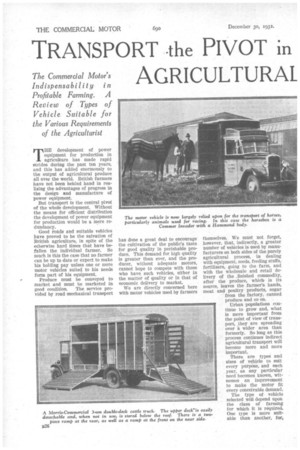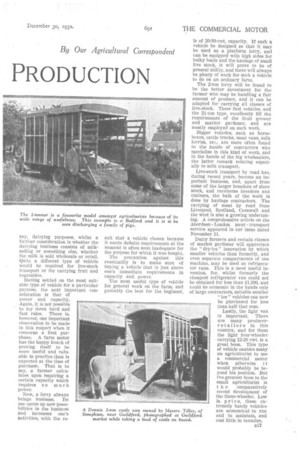TRANSPORT the PIVOT in
Page 40

Page 41

If you've noticed an error in this article please click here to report it so we can fix it.
AGRICULTURAL PRODUCTION
THE development of power equipment for production in agriculture has made rapid strides during the past ten years, and this has added enormously to the output of agricultural produce all over the world. British farmers have not been behind hand in realizing the advantages of progress in the design and manufacture of power equipment.
But transport is the central pivot of the whole development. Without the means for efficient distribution the development of power equipment for production would be a mere redundancy.
Good roads and suitable vehicles have proved to be the salvation of British agriculture, in spite of the otherwise hard times that have befallen the individual farmer. So much is this the case that no farmer can be up to date or expect to make his holding pay unless one or more motor vehicles suited to his needs form part of his equipment.
Produce must be conveyed to market and must be marketed in
good condition. The service provided by road -mechanical transport
has done a great deal to encourage the cultivation of the public's taste for good quality in perishable produce. This demand for high quality is greater than ever, and the producer, without adequate motors, cannot hope to compete with those who have such vehicles, either in the matter of quality or in that of economic delivery to market.
We are directly concerned here with motor vehicles used by farmers themselves. We must not forget, however, that, indirectly, a greater number of vehicles is used by manufacturers on both sides of the purely agricultural process, in dealing with equipment, seeds, feeding stuffs, fertilizers, going •to the farm, and with the wholesale and retail delivery of the finished commodity, after the produce, which is its source, leaves the farmer's hands, meat and poultry products, sugar • from the factory, canned produce and so on. Urban populations continue to grow and, what is more important from the point of view of transport, they are spreading over n wider area than formerly. So long as this process continues indirect agricultural transport will become more and more important.
There are types and sizes of vehicle to suit every purpose, and each year, as any particular need becomes known, witnesses an improvement to make the motor fit every conceivable demand.
The type of vehicle selected will depend upon the class of farming for which it is r6quired. One type is more suitable than another, for,
say, dairying purposes, whilst a further consideration is whether the dairying business consists of milkselling or something else, whether the milk is sold wholesale or retail. Quite a different type of vehicle would be required for live-stock transport or for carrying fruit and vegetables.
Having settled on the most suitable type of vehicle for a particular purpose, the next important consideration is that of power and capacity. Again, it is not possible to lay down hard and fast rules. There is, however, one important observation to be made in this respect when it concerns a first purchase. A farm motor has the happy knack of proving itself to be more useful and valuable in practice than is expected at the time of purchase. That is to say, it farmer calculates upon requiring a certain capacity which requires so much power.
Now, a lorry always brings business. Its use opens up new possibilities in the business and increases one's activities, with the re suit that a vehicle chosen because it meets definite requirements at the moment is often soon inadequate for the purpose for which it was bought.
The precaution against this eventuality is to make sure of buying a vehicle that is just above one's immediate requirements in .capacity and power.
The most useful type of vehicle for general work on the farm, and probably the best for the beginner, is of 20-30-cwt. capacity. If such a vehicle be designed so that it may be used as a platform lorry, and can be equipped with high sides for bulky loads and the haulage of small live stock, it will prove to be of general utility, and there will always be plenty of work for such a vehicle to do on an ordinary farm.
The 2-ton lorry will be found to he the better investment for the farmer who may be handling a fair amount of produce, and it can be adapted for carrying all classes of livestock. These fast vehicles, and the 2i-ton type, excellently fill the requirements of the fruit grower and market gardener, and are mostly employed on such work.
Bigger vehicles, such as horse boxes, cattle trucks, meat vans, milk lorrieS, etc., are more often found in the hands of contractors who specialize in this kind of work, and in the hands of the big wholesalers, the latter remark relating especially to milk transport.
Live-stock transport by road has,
during recent years, become an important business, and, apart from some of the larger breeders of show stock, and racehorse breeders and trainers, the bulk of the work i3 done by haulage contractors. The carrying of meat by road from Liverpool, Scotland, Cornwall and the west is also a growing undertaking. A comprehensive article on the Aberdeen London meat transport service appeared in our -issue dated November 11.
Dairy farmers and certain classes of market gardener will appreciate the " dry-ice " innovation by which smaller vehicles than formerly, and even separate compartments of one machine, may •be used as refrigerator vans. This is a most useful invention, for, whilst formerly the cheapest refrigerator van could not be obtained for less than £1,200, and could be economic in the hands only of large contractors, suitable smaller "ice" vehicles can now be purchased for less than half that sum.
Lastly, the light van is important. There are many producerretailers in this country, and for them
the light four-wheeler carrying 12-20 cwt. is a great boon. This type of vehicle enables many an agriculturist to use a commercial motor when otherwise i t would probably be beyond his position. But the greatest boon to the small agriculturist is
t h a comparatively recent development of the three-wheeler. Low in price, these extremely handy vehicles are economical to run and to maintain, and cost little in taxation.




























































































